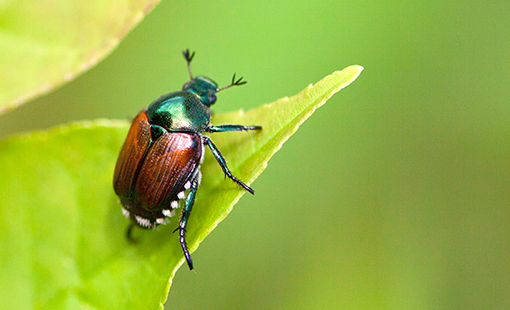
Controlling Japanese Beetles in Your Garden
Japanese beetles were not much of a problem in the United States until about 1919, when this ravenous native of Japan began a serious invasion, probably after hitchhiking to North American on imported ornamental plants. Today, they are a serious nuisance to gardeners and farmers across North America. The adult Japanese beetles that eat so many plants are about 3/8-inch long, with a shiny, metallic green body and copper-brown wing covers. However, not all metallic green or copper beetles are Japanese beetles. To make sure you’re dealing with Japanese beetles, check their undersides for five small, white tufts under the wing covers and an additional tuft at the end of the abdomen.
Why They Are a Problem
While individual Japanese beetles aren’t a particular threat, these insects tend to hatch in very large numbers, and when they congregate on a shrub, tree, or other plants, they can quickly defoliate it. They tend to run in cycles; some years are almost devoid of beetles, while in other years they are present everywhere. When there is an infestation, it is often a very large one that can seriously damage large numbers of plants. The sheer numbers make it hard to eliminate them, but there are still steps you can take to control and prevent Japanese beetles.
There’s a wide smorgasbord of plants for Japanese beetles to feast on—more than 300 varieties of trees, shrubs and non-woody plants. During a year with a serious infestation, gardeners may feel as though there is no plant that the beetles don’t enjoy.
Understanding the Japanese Beetle Lifecycle
Beetles typically go through four stages of development. It’s important to know when they are passing through each stage in your climate because control methods are different for each stage. The life stages for the Japanese beetle are:
- Egg: The mature beetles lay small, oval, white eggs in the soil. If moisture is sufficient, the eggs will absorb it and enlarge, becoming rounder as they do.
- Larvae: This is the white grub stage that is so familiar (and so damaging) in lawns. Japanese beetle larvae have a V-shaped series of bristles on their raster (the underside of the tip of the abdomen). Grubs will grow in length as they feed and mature.
- Pupae: The pupae stage is where the grub starts to transform into a beetle. Japanese beetle pupae start as cream-colored and age to a reddish-brown.
- Adult beetle: The adult beetles are less than 1/2-inch long, and the shell is shiny, metallic green. Adults emerge from the ground between May and June, depending on your area. They live for about 30 to 50 days, during which they feed and reproduce.
When the first beetles emerge from the ground, they immediately look for suitable plants and start feeding. They also send out an odor known as a congregation pheromone to signal later emerging beetles where to go. Mating starts soon after.
The female beetle feed on plants for a couple of days, then burrow into the soil to lay their eggs. Shortly after, they will return to feeding and mating and start the cycle all over again. By the end of the season, each female Japanese beetle will have laid about 50 eggs.
Eggs develop at different rates in different soil temperatures, developing most rapidly in warm soils of about 80 to 90 degrees Fahrenheit. When soil conditions temperatures are ideal for eggs to hatch, you can expect an infestation of lawn grubs to follow shortly, with large numbers of beetles appearing in the following year.
Once the eggs develop into larvae, they will move up toward the surface of the soil and start feeding on roots and organic matter. In large numbers, these grubs can cause severe damage to a lawn, sometimes killing off large areas. This is why grub control is usually applied in late summer to fall. The pesticide needs to be applied while the grubs are feeding on the grass roots.
As the soil cools and the grubs mature, they move back down deeper into the soil for winter. They’ll stay there until the soil warms in the spring, at which time they burrow back up toward the surface where they’ll pupate and eventually emerge as adults. The cycle now begins all over.
When to Control Japanese Beetles
The proper timing for controlling Japanese beetles depends on what stage of the beetle’s lifecycle you are trying to attack.
- Hand-picking or spraying with chemical or natural pesticides should be done while the beetles are actively feeding on plants, a period that lasts for roughly a month in late May, June, or July.
- Attacking the larvae stage (the grubs) is normally done in late summer to fall when the grubs are maturing and moving upward to feed on roots.
Information courtesy of TheSpruce.com

 Adams Fairacre Farms
Adams Fairacre Farms